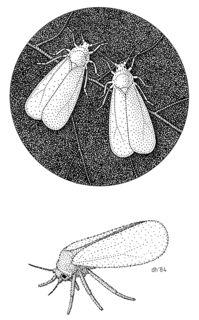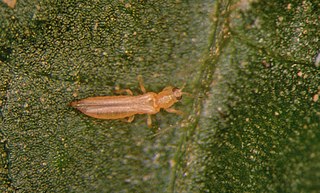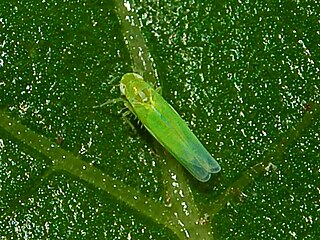Related Research Articles

Hemiptera is an order of insects, commonly called true bugs, comprising over 80,000 species within groups such as the cicadas, aphids, planthoppers, leafhoppers, bed bugs, and shield bugs. They range in size from 1 mm (0.04 in) to around 15 cm (6 in), and share a common arrangement of sucking mouthparts. The name "true bugs" is often limited to the suborder Heteroptera. Many insects commonly known as "bugs", especially in American English, belong to other orders; for example, the lovebug is a fly and the May bug and ladybug are beetles.

Whiteflies are Hemipterans that typically feed on the undersides of plant leaves. They comprise the family Aleyrodidae, the only family in the superfamily Aleyrodoidea. More than 1550 species have been described.

The silverleaf whitefly is one of several species of whitefly that are currently important agricultural pests. A review in 2011 concluded that the silverleaf whitefly is actually a species complex containing at least 40 morphologically indistinguishable species.

The Miridae are a large and diverse insect family at one time known by the taxonomic synonym Capsidae. Species in the family may be referred to as capsid bugs or "mirid bugs". Common names include plant bugs, leaf bugs, and grass bugs. It is the largest family of true bugs belonging to the suborder Heteroptera; it includes over 10,000 known species, and new ones are being described constantly. Most widely known mirids are species that are notorious agricultural pests that pierce plant tissues, feed on the sap, and sometimes transmit viral plant diseases. Some species however, are predatory.

Trialeurodes vaporariorum, commonly known as the glasshouse whitefly or greenhouse whitefly, is an insect that inhabits the world's temperate regions. Like various other whiteflies, it is a primary insect pest of many fruit, vegetable and ornamental crops. It is frequently found in glasshouses (greenhouses), polytunnels, and other protected horticultural environments. Adults are 1–2 mm in length, with yellowish bodies and four wax-coated wings held near parallel to the leaf surface.

Trialeurodes is a large genus of whiteflies in the family Aleyrodidae.

Coenosia attenuata, commonly called "hunter fly" or well known under the name "killer fly", is a predatory fly belonging to the family Muscidae.

Encarsia formosa is a species of chalcidoid wasp and a well known parasitoid of greenhouse whitefly, one of the first to be used commercially for biological pest control, from the 1920s. They can use at least 15 species of whitefly as a host, including Bemisia tabaci and Aleyrodes proletella.
Tomato yellow leaf curl virus (TYLCV) is a DNA virus from the genus Begomovirus and the family Geminiviridae. TYLCV causes the most destructive disease of tomato, and it can be found in tropical and subtropical regions causing severe economic losses. This virus is transmitted by an insect vector from the family Aleyrodidae and order Hemiptera, the whitefly Bemisia tabaci, commonly known as the silverleaf whitefly or the sweet potato whitefly. The primary host for TYLCV is the tomato plant, and other plant hosts where TYLCV infection has been found include eggplants, potatoes, tobacco, beans, and peppers. Due to the rapid spread of TYLCV in the last few decades, there is an increased focus in research trying to understand and control this damaging pathogen. Some interesting findings include virus being sexually transmitted from infected males to non-infected females, and an evidence that TYLCV is transovarially transmitted to offspring for two generations.

The western flower thrips [Frankliniella occidentalis (Pergande)] is an invasive pest insect in agriculture. This species of thrips is native to the Southwestern United States but has spread to other continents, including Europe, Australia, and South America via transport of infested plant material.
Neoseiulus cucumeris, the cucumeris mite, is a species of predatory mite in the family Phytoseiidae. It is used in biological pest control of western flower thrips in cucumber and some other greenhouse crops.

Encarsia is a large genus of minute parasitic wasps of the family Aphelinidae. The genus is very diverse with currently about 400 described species and worldwide distribution. The number of existing species is expected to be several times higher because many species are still undescribed. Encarsia is a very complex genus, with specimens showing both inter- and intra-specific variations, making morphological classification difficult.

Chrysoperla carnea, one of the species of common green lacewing, is an insect in the Chrysopidae family. Although the adults feed on nectar, pollen and aphid honeydew, the larvae are active predators and feed on aphids and other small insects. It has been used in the biological control of insect pests on crops.

Empoasca decipiens is a species of leafhopper belonging to the family Cicadellidae subfamily Typhlocybinae. The adults reach 3–4 millimetres (0.12–0.16 in) of length and a are homogenously green with whitish markings on its pronotum and vertex. E. decipiens is commonly referred to as the “green leafhopper” because of its colouration. The absence of clear stripes along the forewings can easily distinguish it from the similar leafhopper species E. vitis, but distinguishing it from other leafhoppers with the same colouration requires examination under a microscope. It is present in most of Europe, in the eastern Palearctic realm, in North Africa, in the Near East, and in the Afrotropical realm. Both nymphs and adults of this small insect are considered to be a very destructive pests on field crops, vegetables and greenhouse plants.
Ablerus macrochaeta is a parasitoid wasp that attacks the silverleaf whitefly and Aleurocanthus inceratus. The latter is a serious pest of sweet potato in China.
Dicyphus hesperus is a species of true bug in the family Miridae. It is a generalist predator of other insects and also feeds on plant tissues. It is native to North America and has been used there in biological control of agricultural pests, especially whitefly on tomatoes.
Typhlodromips swirskii, the Swirski mite, is a species of predatory mite in the family Phytoseiidae. It is used in biological pest control of western flower thrips in greenhouse or indoor grown crops.

Aleurocanthus spiniferus, the citrus spiny whitefly, is an important pest of citrus and tea plants. They are part of the order Hemiptera, and the family Aleyrodidae, where more than 1550 species have been described. A. spiniferus is indigenous to parts of tropical Asia, where it was first discovered in Japan. Since its discovery, it has now spread to numerous continents including Africa, Australia, America, Pacific Islands and Italy. Wherever it is found, it has become a highly destructive pest. Two populations of A. spiniferus have been found according to the plant or crop they infest: the citrus spiny whitefly, as well as the tea spiny whitefly.
Aschersonia aleyrodis is a fungal pathogen affecting various species of insect. It has been shown to control the silverleaf whitefly in laboratory and greenhouse conditions.
Axinoscymnus puttarudriahi, is a species of lady beetle native to India and Sri Lanka.
References
- 1 2 3 "Macrolophus caliginosus". Terralia (in Spanish). 2014-12-22. Retrieved 2015-07-18.
- ↑ Bonato, Olivier; Couton, Louise; Fargues, Jacques (2006). "Feeding Preference of Macrolophus caliginosus (Heteroptera: Miridae) on Bemisia tabaci and Trialeurodes vaporariorum (Homoptera: Aleyrodidae)". Journal of Economic Entomology. 99 (4): 1143–1151. doi:10.1603/0022-0493-99.4.1143.
- ↑ Vincent, Charles; Goettel, Mark S.; Lazarovits, George (2007). Biological Control: A Global Perspective: Case Studies from Around the World. CABI. pp. 128–135. ISBN 978-1-84593-266-4.
- ↑ Lucas, Éric; Alomar, Oscar (2002). "Impact of the presence of Dicyphus tamaninii Wagner (Heteroptera: Miridae) on whitefly (Homoptera: Aleyrodidae) predation by Macrolophus caliginosus (Wagner) (Heteroptera: Miridae)". Biological Control. 25 (2): 123–128. CiteSeerX 10.1.1.627.454 . doi:10.1016/S1049-9644(02)00054-3.